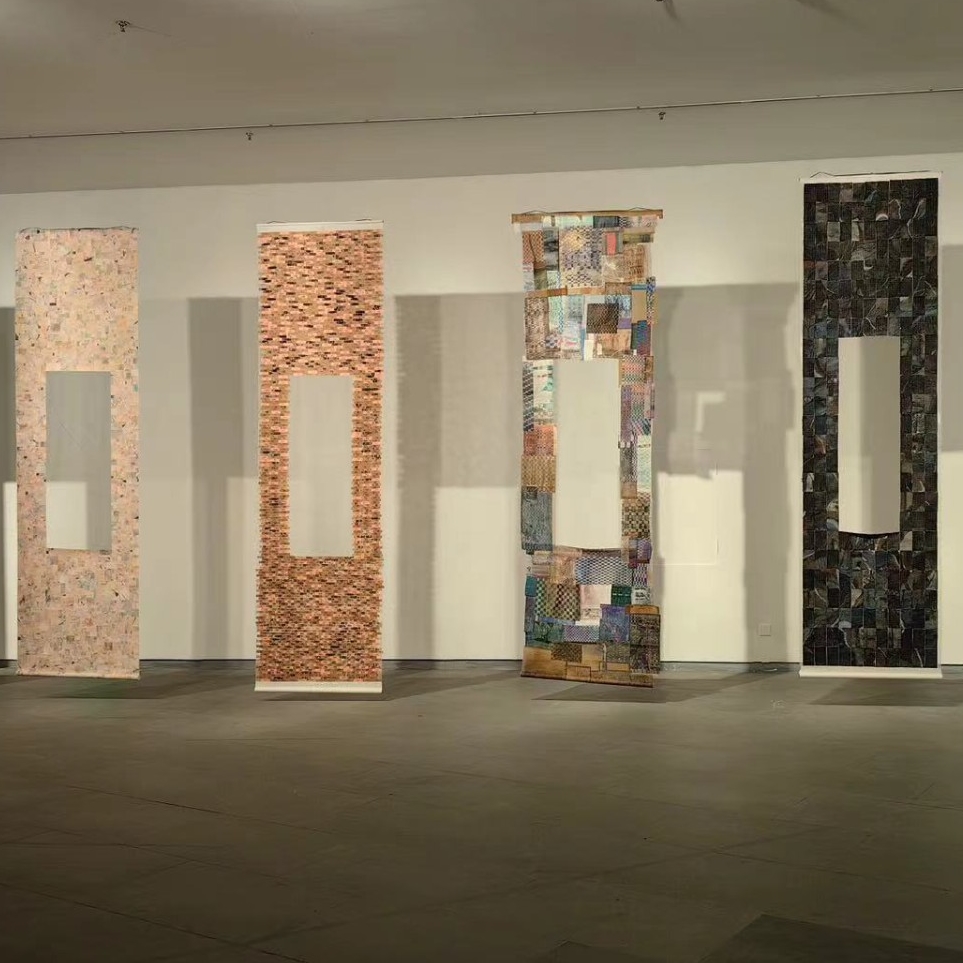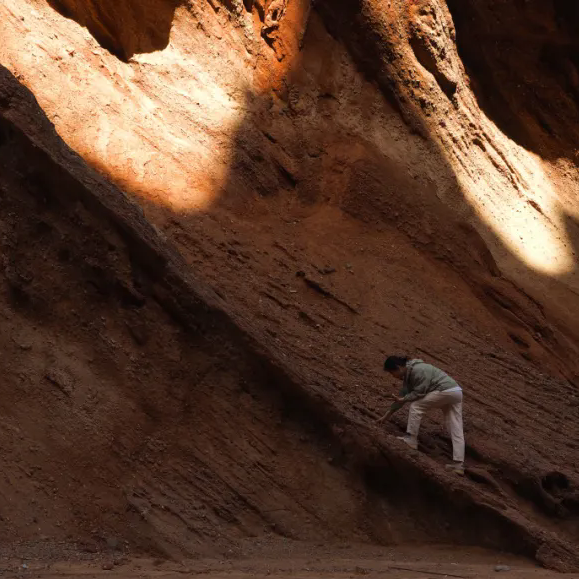
How much do people fear diseases and death? An individual’s disease and death do not just mean the destruction and end of human life, but it also has a close relationship with the environmental changes and development of living systems. Since the twentieth century, people have been creating miracles while also bringing about disasters. The material wealth of society has grown rapidly but meanwhile the manmade damages to the natural and biological environment also repeatedly occur.
Although diseases have always accompanied human life, pain makes us feel alive and in a sense proves our existence. It is through the exploration of thinking about diseases, studying diseases, fearing disasters while avoiding death that people are committed to seeking comfort and healing. Along with the development of human civilization, artists have keenly provided a variety of creations portraying diseases and their connotations, and further give us a profound warning of human behavior while exploring the universal topic such as healing.
When it comes to the impact of diseases on contemporary art, the AIDS crisis is an unavoidable topic. In the decade after AIDS “jumped” from the Caribbean to New York City in 1970 or 1971, hundreds of thousands of U.S. lives were taken by the disease of human immunodeficiency virus (HIV). Richard Burns, who was the Head of New York’s Lesbian, Gay, Bisexual & Transgender (LGBT) from 1986 through 2009, told Mashable [1] that New York City in the 1980s felt like a war zone, “you were living with fear and constant dying and caregiving and shells shock.”
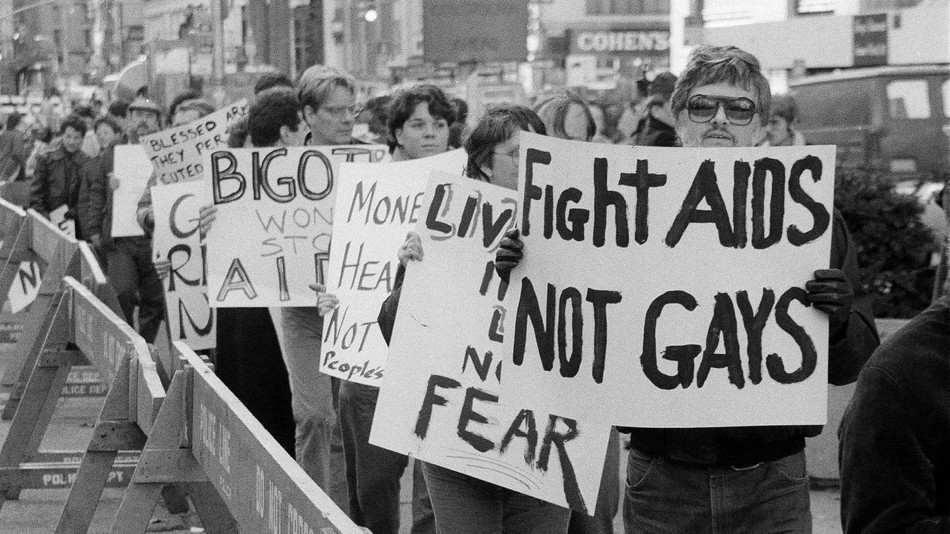
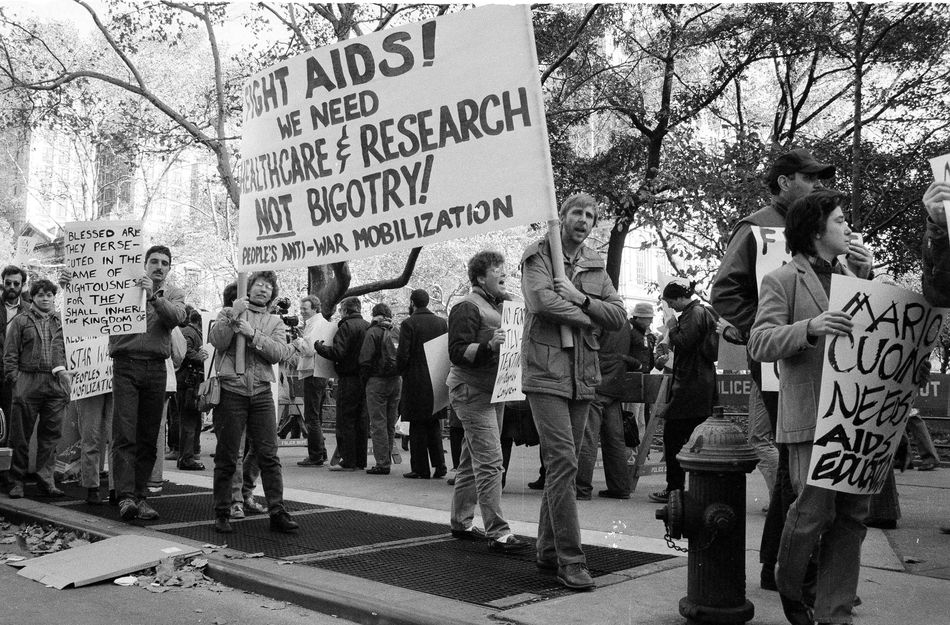
Demonstrators protest near New York City’s City Hall on Nov. 15, 1985,
as City Council committee considered legislation to bar
students and teachers with the AIDS virus from public schools.
IMAGE: APAP PHOTO/RICK MAIMA,
Source: https://mashable.com/2016/10/26/aids-epidemic-study/
Even before the health institutions recognized the AIDS crisis, artists started drawing attention to the issue. Art that started to concentrate on this controversial theme have emerged from a broader cultural community in the 1980s, the questions about AIDS opened significant debates and they later triggered the activities fighting for equal rights of minorities. Since then, people have gradually realized that art can also participate in the dialogue of social issues, and they further exert some significant influence.

Niki de Saint Phalle – AIDS, you can’t catch it holding hands, 1987, book. Photo via artnews.com
It was not until 1985 that U.S. President Reagan mentioned “AIDS” in a public speech. Since the majority of public did not understand the source and transmission of the virus in the decade before that, many artists and creators had been affected by the crisis, Keith Haring(1958-1990) was one of them. Although he felt frustrated for the disease , he did not fall into the depression and he founded the Keith Haring Foundation contributing to AIDS research and therapy as well as children’s welfare. He kept working on art until the end, as he wrote in his diary, “all of the things that you make are a kind of quest for immortality. Because you’re making these things that you know they have a different kind of life. They don’t depend on breathing, so they’ll last longer than any of us will. Which is sort of an interesting idea, that it’s sort of extending your life to some degree.”[2]
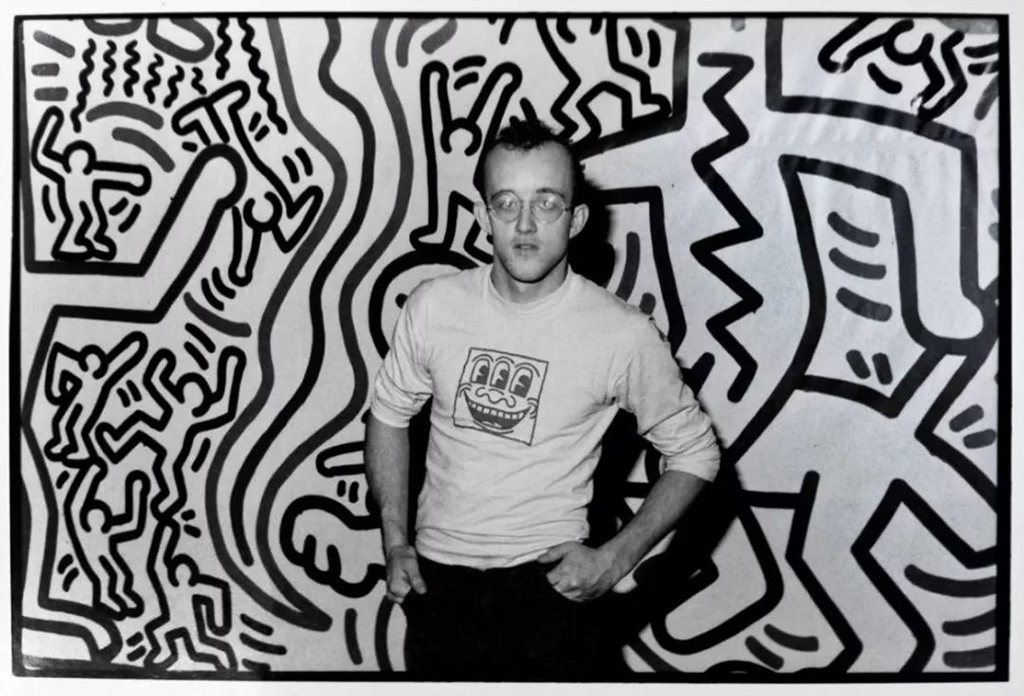
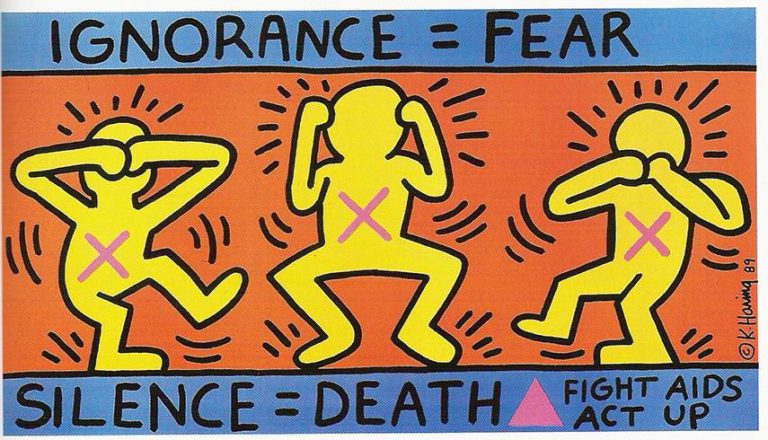
Keith Haring, “Ignorance = Fear” (1989), Courtesy of the Keith Haring Foundation
The AIDS epidemic crisis became the topic of artworks in the 1980s by many American artists using diversified methods and transformed the world of contemporary art significantly. “Anger, confusion, fear and defiance, all triggered by the artists’ existential situation and the emergence of culture which formed a response to the crisis, having immensely changed the dominant self-reflexive art practices, bringing art closer to politics and life”.[3]
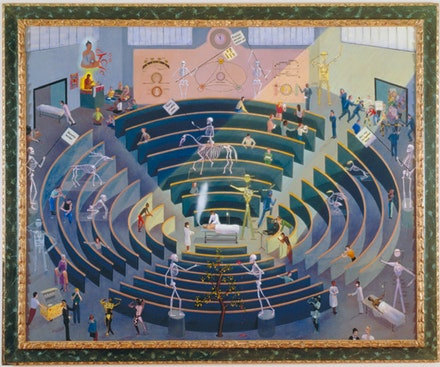
Frank Moore, “Arena,” 1992. Oil and silkscreen on canvas mounted on wood, in antique gilded frame. 61 x 72”. Collection of Gian Enzo Sperone, Sent, Switzerland. Image: Courtesy Sperone Westwater, New York.
Frank Moore (1953 – 2002) portrays a brilliant parade of DNA manipulations, human engineering and genomes in his work, with which he conveyed the reality of his purgatory and his own dream of hell, on which he stated that, “as beautiful as our modern Arcadia may appear to be, it is a beauty that is alloyed with all the complexities and toxicities of modern life. ”[4]
These complexities and toxicities are still spreading as humans trample on the destruction of non-renewable resources and the remains of other animals and stride into the “brave new world” in the 21st century. In addition to the diseases that human beings have not completely overcome, we also are confronted with more threats and challenges.

Eric Avery, “Emerging Infectious Diseases” (2000), linoleum block print over lithograph (Department of Rare Books and Special Collections, Graphic Arts Collection, Princeton University Library © Eric Avery)
The recent exhibition throughout history and across cultures, entitled State of Health: Visualizing Illness and Healing (November 2, 2019 through February 2, 2020) presented by the Art Museum of Princeton University, featured over eighty works of globe-spanning art. [5] “Emerging Infectious Diseases” (2000) by Eric Avery examines the societal anxiety about pandemics and infectious disease, the instantaneous switching between life and death, which has a sobering connotation.

Russian artist Paulina Siniatkina, “Hold Your Breath”, was exhibited at the headquarters of the World Health Organization (WHO) in Geneva on 24 March 2017 (World TB Day).
For artists who have been inspired by illness, “gratitude outweighs pain”. In 2015, Russian artist Paulina Siniakina spent 6 months and 17 days in a TB clinic in Moscow. She went through fear, misunderstanding, anger, despair, loneliness, silence, love, friendship and hope.[6] “Hold Your Breath” series tells stories of her and other people who shared her fate, which she takes as a weapon to fight the stigma of disease and urges people not to be afraid to talk about TB.
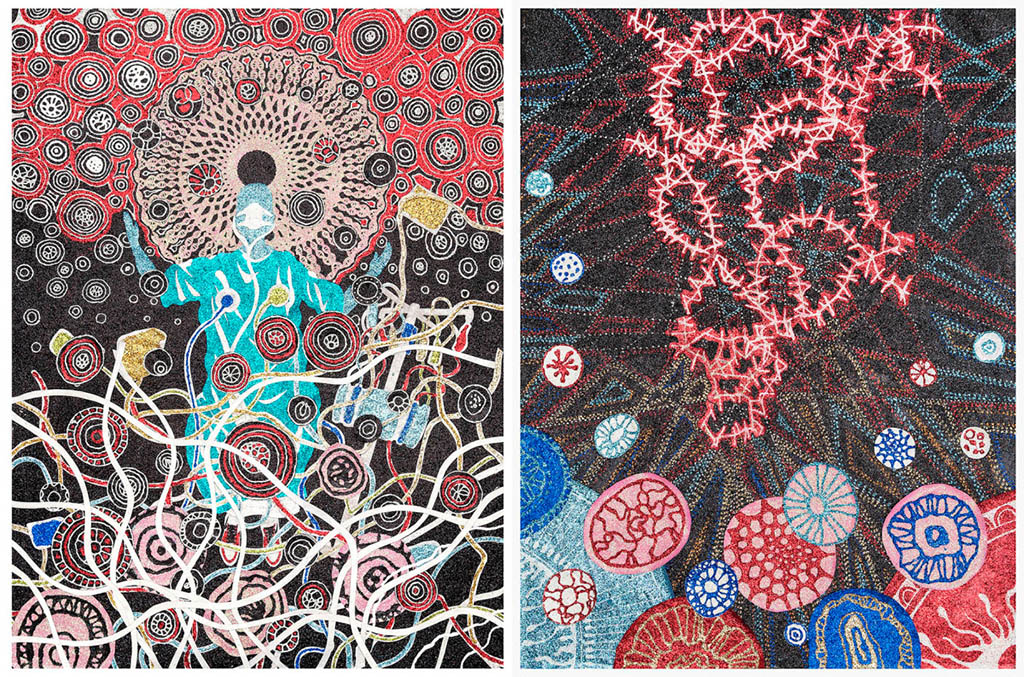
From left: “Ascension” by Dylan Mortimer, 2016; “Rejection that Brings Reconciliation” by Dylan Mortimer, 2019(COURTESY OF DYLAN MORTIMER)
American artist Dylan Mortimer, has endured two double lung transplants during his life, cystic fibrosis clogged his lungs making him feel it is hard to breathe, but art has become a way for him to process and explore his disease. Inspired by the structure of lungs and cells of his body, he creates with their patterns and shapes yet every piece holds the weight of his pain. But he still believes that “there is hope in the most hopeless situations, that’s certainly what has kept me alive.”[7]
In addition to starting from their own experiences, there are more international artists using scientific and medical perspectives, exploring and questioning the relationship between humankind to bacteria, viruses and infectious diseases, as well as the interventions of biological research and new technologies.
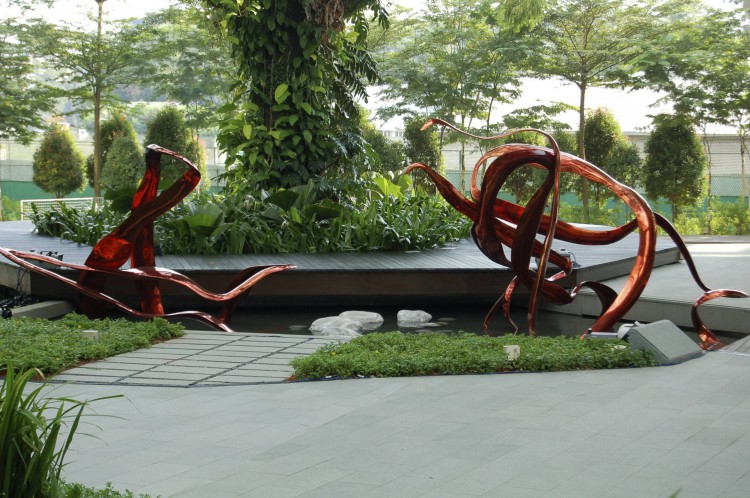
“SARS Inhibited” Materials: bronze, paint, rocks. Dimensions: 30′ wide, 9′ tall ©Mara G. Haseltine
A bronze sculpture entitled “SARS Inhibited” (2006) by Mara G. Haseltine permanently stands in front of the Epi-Center of Biopolis in Singapore. This outdoor sculpture was created to memorize the functions of the SARS Protease Inhibitor discover by the international team of scientists working at Biopolis. In a mimetic form, it vividly integrates biotechnology with artistic expression, hope of healing with surrounding environment.

ArchaeaBot by Anna Dumitriu and Alex May, Photo credit Vanessa Graf at Ars Electronica 2018
Source: http://digicult.it/articles/an-engagement-with-bacteria-interview-with-anna-dumitriu/.
As an artist-in-residence with the Modernizing Medical Microbiology Project at the University of Oxford, Anna Dumitriu’s creations span sculpture, installation, textiles and biological work. With "ArchaeaBot: A Post Singularity and Post Climate Change Life-form", Anna Dumitriu and Alex May imagine and prepare humans for a way of living to battle the catastrophically scorching umwelt.

“Anatomy of an Interconnected System” (2017). Performative lecture (Media: animal bones, blackboard, chalk, soil, cotton cloth, animal blood, caput mortum pigment. Duration: 2 h 30′). Source: www.margheritapevere.com
Focusing on the complicated relationship between human and nature in context of current environmental crisis, “Anatomy of an Interconnected System” (2017) is a performative lecture conducted by Margherita Pevere. It was commissioned by Art Laboratory Berlin and realized with the support of the Berlin Senate Department for Culture and Europe. It contributes to the discussions on how artistic practices that involve living organisms and technology explore the interconnection between humans and the biosphere in this high-tech age.
From the health and survival of human beings to the coexistence and healing of human beings and the environment, the participation and intervention of biotechnology, art does not only provide rich and diverse interpretations for people but it also proposes more possibilities and suggestions. Diseases are not that terrible, what’s more terrible is that one lacks courage and imagination. Whether it is for the rights of vulnerable groups or the future of the entire human race, even the earth, all of which have gained a deeper understanding and evoked more attention and reflection due to the participation of artists.
References:
[1] Gallucci, M. Researchers exonerate 'Patient Zero' in U.S. AIDS epidemic, https://mashable.com/2016/10/26/aids-epidemic-study/ , October 7, 2016.
[2] Haring, K. About Haring, http://www.haring.com/!/about-haring/transitions.
[3] Dačić, A. Art in America : Before and After AIDS Crisis, https://www.widewalls.ch/art-aids-hiv-america/ , December 1, 2017.
[4] Oisteanu, V. FRANK MOORE Toxic Beauty, https://brooklynrail.org/2012/10/artseen/frank-moore-toxic-beauty, Oct 2012 Issue.
[5] Art Museum of Princeton University, State of Health: Visualizing Illness and Healing, https://artmuseum.princeton.edu/art/exhibitions/3617.
[6] Wold Health Organization, "Hold Your Breath", paintings made by Russian artist while in a TB clinic, https://www.who.int/features/2016/russia-tuberculosis/en/, September 2017.
[7] Anthony, C. For Artist Inspired By Illness, ‘Gratitude Outweighs Pain’, https://khn.org/news/for-artist-inspired-by-illness-gratitude-outweighs-pain/view/repubish/, December 2, 2019.
[8] Marietta, D. An Engagement with Bacteria: Interview with Anna Dumitru, http://digicult.it/articles/an-engagement-with-bacteria-interview-with-anna-dumitriu/.


